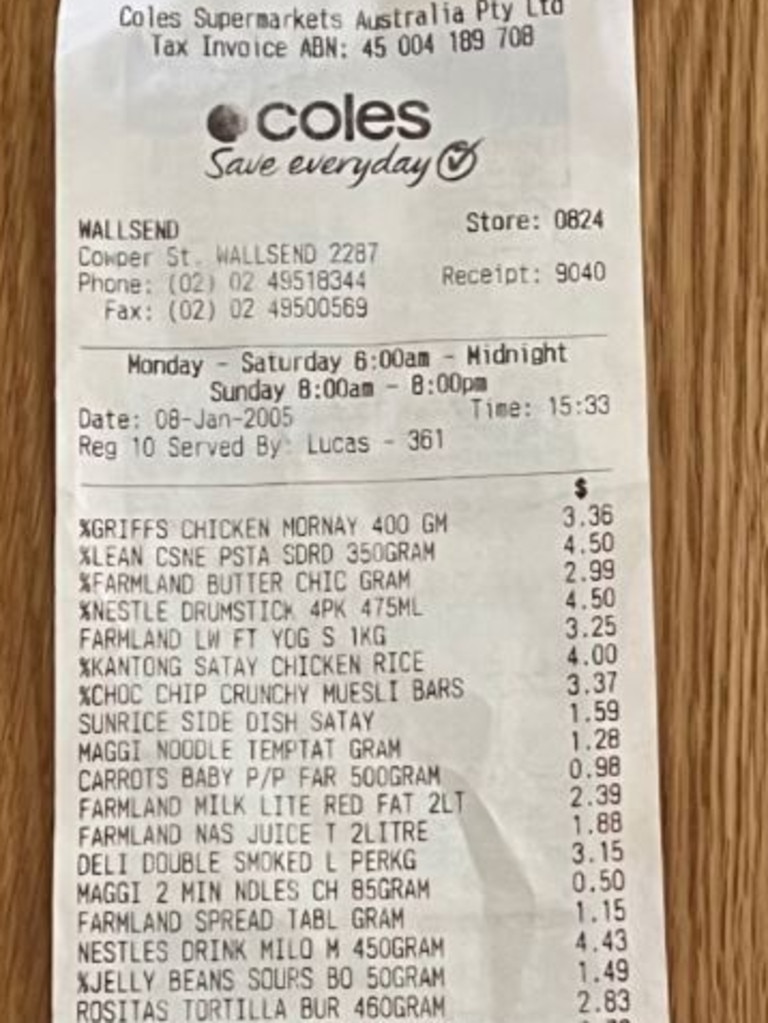‘Absolutely crazy’: 2005 receipt you’ll want to see
An Aussie mum has revealed the old receipt she found and the “crazy” 2024 reality it exposes.
An Australian mum has revealed that her grocery bill has almost doubled in less than two decades because of the cost-of-living crisis.
Across the board, living in Australia has become more expensive, whether it’s petrol, rent, or your mortgage.
Rachel Petersen, 35, is a mum of three who lives in Newcastle and she started a big conversation about grocery prices online by sharing her Coles receipt from 2005.
The mum didn’t just show how much groceries cost in the early 2000s, she also decided to do a shop mimicking the list to see the price difference compared to today.
She did her best to copy the receipt, sometimes having to substitute for similar brands if the original items were no longer available.
Both receipts show a basic shopping list, including milk, butter, chicken, juice, carrots, tomato sauce, two-minute noodles, and an array of everyday items.
On both receipts, she bought 33 items in total, but in 2005, that shop cost her $77.01, and in 2024, the nearly identical grocery haul cost her $132.29.


Ms Petersen expected the price difference to be “worse”, but explained that the change was jarring when she first stumbled across her old receipt.
“When I first saw the Coles receipt, the prices shocked me. The total amount shocked me,” she told news.com.au.
“When comparing to today’s prices online, I noticed our bread weighs 100g-150g less, which sucks, but of course, it weighs less; shrinkflation is so obvious now.”
The receipt comparison drew mixed reactions online.
“I thought it would be so much worse. But I bet the stuff is like half the size now,” one mused.
“That isn’t even bad for being almost 20 year ago,” another argued.
“Inflation is crazy,” someone else pointed out.
“This is the world we live in now! Disappointed is an understatement,” someone else wrote.
“That is absolutely crazy how much prices have gone up! Imagine another 10 years,” another said.
“Not that bad to be honest, and in 1985 it would have been $30. Prices are always going to increase. Instead of complaining, invest and get rich,” someone else advised.
A Coles spokesperson told news.com.au that prices have increased over the years because of a number of reasons.
“The items being compared in this video are from nearly 20 years ago and the products being compared aren’t like for like.”
“We know that increased grocery prices are influenced by inflation and economic changes due to global events such as wars and pandemics impacting supply chain disruptions.”
“Rising energy, fuel, and other costs have contributed to increased grocery prices this year. These costs make it more expensive for suppliers to produce goods, and for us to operate our stores and transport products. We’ve managed to keep price inflation in our supermarkets below the rate reported by the ABS.”
The spokesperson added that the cost of living crisis has created a “challenge” for many of their customers.
“We are focused on helping them find great value in our stores through weekly specials, value campaigns, Flybuys and exclusive brands”.


Financial comparison website Finder found that the average Aussie household spends $201 weekly on groceries. That’s up from an average of $182 per week in October 2023.
Grocery bill stress is also incredibly high, with 42 per cent of Australians ranking groceries as one of their top three most stressful expenses in October.
That’s even higher than the 40 per cent who rank mortgage as their most stressful expense.
In April Finder calculated the cost of a basket of 23 goods, with average prices from 2022 and 2024, using data from Woolworths and Coles.
The study found that people were now paying about $406 compared to $361 in 2022 – that’s an average increase on this basket of over 12 per cent or an extra $46 each week.
Ms Petersen said that the cost-of-living crisis has “changed” the way she shops because she has to be budget-minded.
“I tend to do a big produce and meat shop at the start of the week at Harris farm and get the rest at Aldi,” she said.
“I do love the farmers’ markets on a Sunday as well, but it’s too easy to get carried away and overspend.
“My next goal is getting a chest freezer so we can bulk buy quarter-beast beef. Usually, families buy quarters or halves, depending on how much freezer space they have.”
Ms Petersen said that the biggest change in her shopping is that she’s become an “ingredients household”, but she said the plus side is that it gets the kids cooking because there aren’t easy pre-packaged on hand.
“There’s been weeks where it’s been a struggle but we make it work,” she said.






